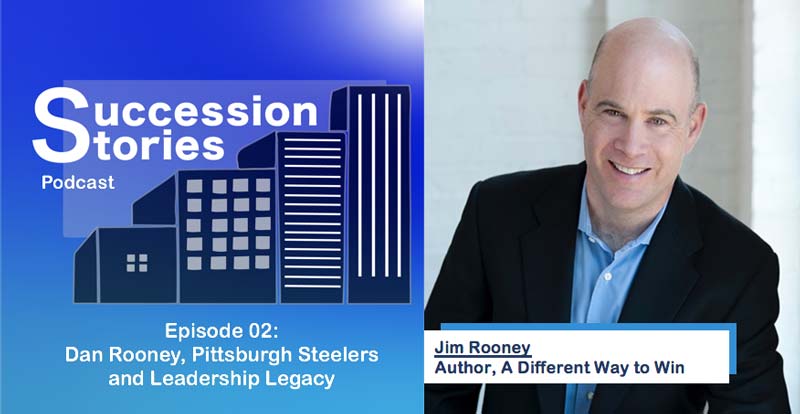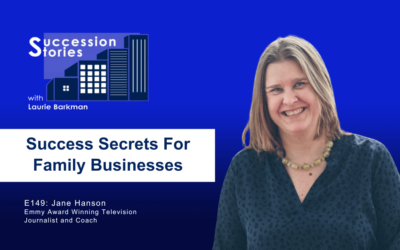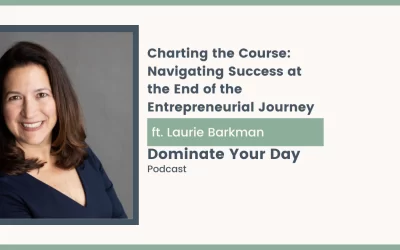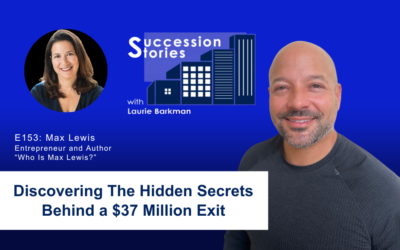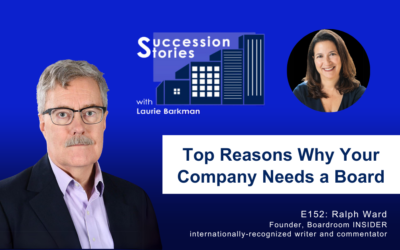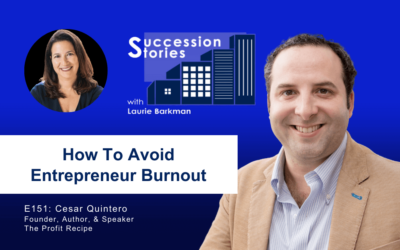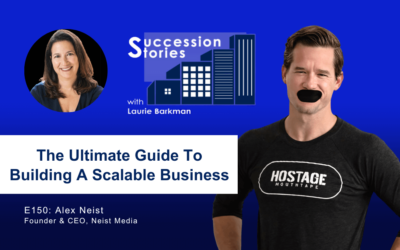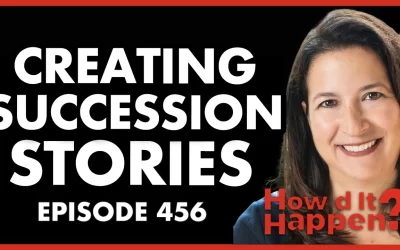Stream the episode
On this episode of Succession Stories, I spoke with Jim Rooney, entrepreneur and author of, A Different Way to Win: Dan Rooney’s Story from the Super Bowl to the Rooney Rule.
Jim wrote the book about his father and the family business, the Pittsburgh Steelers—a $2.5 Billion enterprise with millions of loyal fans around the world.
We talked about Dan Rooney’s legacy– from his successful career in sports, to the leadership ethos of the Steeler enterprise, to the creation of the NFL policy requiring league teams to interview ethnic-minority candidates for head coaching and senior football operation jobs, now known as the Rooney Rule.
Jim shared powerful stories about how Dan Rooney inspired leadership, influenced the Steelers culture, and some of his foundational business principles:
– Run a successful business that has meaning beyond the bottom line
– Take the long view, even if others focus on short term gains
– Sometimes it has to get worse before it gets better
– Demonstrate how a culture has to change to support a new view– the legacy of the Rooney Rule
Even if you’re not a football or a Steelers fan, Dan Rooney’s legacy of leadership is sure to inspire.
Looking for more episodes?
For a full list, visit the Succession Stories Podcast page
Subscribe
The easiest way to get more episodes of Succession Stories is to subscribe:
- Apple Podcast (formerly iTunes) – give a 5-star rating if you enjoyed the show
- Spotify
- Google Play
- Stitcher
- Or use RSS in your favorite podcasting software
Sign-up to receive email notifications of new episodes.
Show Links
Jim Rooney’s Bio on LinkedIn
“A Different Way to Win” on Facebook
Full Transcript
Laurie Barkman (00:04):
Jim, welcome to Succession Stories. I’m really excited you’re here. Super excited to talk with you today. I live in Pittsburgh and I certainly know the Rooney name and its affiliation with football and the family enterprise, the Pittsburgh Steelers. The name may not be familiar to people if they don’t watch football, but I imagine that with all the fans all over the world, it is a team that people know. There are Steeler bars literally everywhere even in cities you least expect. The team is the seventh oldest in the NFL and there’s a strong legacy for the Pittsburgh Steelers. I’m curious what it was like when you were growing up. Did you realize when you were growing up how important the Steelers were to their fans? And I was curious, at what point did you really start to appreciate the notoriety of the team as a beloved brand?
Jim Rooney (01:09):
So, well, first, thank you for having me. It’s great to be with you, Laurie. And, and I think what you’re doing is very interesting and cool. I’m glad you’ve asked me to be a part of it. I would say that we have been involved really in the sports industry for more than a hundred years, if you count my grandfather’s contribution. And certainly his contribution to the Steelers as its founder is significant. So this is an industry that we’ve known. I would say that we’ve made a contribution to building it and developing it into what it has become in many ways. And sometimes trying to caution against some of the massive growth. Because I think that sometimes the growth of the industry does have an impact on the sport and, I think that although we’ve made it more available to folks, sometimes the quality of the sport does suffer when the business gets too far out in front of the sports.
Jim Rooney (02:10):
So that’s something that I think the members of my family that had been involved in this industry have tried to pay attention to. And I think that relates to your question. We see fans not just as customers, certainly they are, and we understand the business side. But I like to think we see them as neighbors. They’re people that have choices with what type of entertainment they engage in, where they put their investments, how they spend their lives. I think we’ve tried to build both a brand and an approach that has met and respected what is important to people who choose to be Steeler fans. I hope that we’ve represented them well and done it in a way consistent with what they see as important in their lives.
Jim Rooney (03:04):
More specifically, you asked when did I I recognize that? I don’t know if I was four or five years old, but I remember being in this hotel lobby at a very young age and someone asking me if I had tickets, and that they would buy them from me. And I didn’t know what tickets were, but I was interested in the idea that someone was going to buy these things from me. So my mother grabbed my arm and pulled me away. But from that day forward, I knew that there was something a little different there.
Laurie Barkman (03:32):
You knew at that point you had some special access that maybe some others wanted to get. And I like your comment about being a neighbor. It’s not just a team and the audience, but how can you be neighbors. That’s an interesting point for a brand– expanding that horizon. Thanks Jim, for sharing that background. I want to ask, why did you decide to write the book about your father, Dan Rooney, and what was the toughest part about writing this book?
Jim Rooney (04:04):
Well, a lot of people have come up to me over the last year who are pretty successful and say, Oh, I thought about writing a book. And I usually say, go ahead and write it. But I say it is not an easy process. Writing a book is a challenge. I think in any circumstance, even great writers talk about those challenges. And I don’t put myself in that category, but I think we put a good project together. The reason is there’s a lot of books on leadership out there. I’ve read many of them. I have been motivated by many of the books and the concepts behind the books. Things ranging from self help to the alpha male model and everything in between.
Jim Rooney (04:50):
And I think that leadership is something that’s important. I think my father’s approach to leadership was one that really respected both the hard core standards that are important to success, but also what unfortunately are called the softer sides. I would call them the things that build stability and continuity. Those things that are more subtle and important to leadership. I think those that follow look for those clues maybe in a more significant way and invest in the leaders more when they see clues of people who are willing to look at the humanity involved. I put this story together because I think it’s a story of someone who was successful in a very public way, in an industry that is very recognizable and some of his accomplishments are very well known. I think telling that story in reference, where we all want leaders to be, or how we want leaders to act and their approach. It felt like it was appropriate. I think I got a lot of good stories out. I talked to a lot of people that gave me great content and I think folks will enjoy engaging in those.
Laurie Barkman (06:15):
That was probably a really interesting experience to journey through the past to and learn all these different things about your family that you didn’t know.
Jim Rooney (06:24):
Yeah, it was. I think the biggest context that was given to me that was different than I would expect was from Paul Tagliabue, the NFL Commissioner prior to Roger Goodell [the current Commissioner]. He said to me, your father was the best risk taker I’ve ever known. He said there were other people that take risks. But no one that I’ve ever seen was willing to really get into how he defined risk. And that was getting into the challenging situation, the difficulty, the ambiguity, and not knowing what the outcome was going to be. Not being worried about his reputation per se, or the perception. Really get in there and work on trying to create a solution or a contribution to a challenge, whether it be the Rooney Rule, whether it be labor, his work in Ireland, all of those things. There’s always going to be ongoing challenges around the circumstances or the conditions that he dealt with.
Jim Rooney (07:29):
Certainly his contribution didn’t ultimately create the silver bullet that saved things. But he was always willing to go in there and make a substantial contribution to get involved in a way that was significant and critical, and deal with it over the long run in a way that I think a lot of other people don’t. That reference point or context of risk, my father is pretty much an old white dude, especially if you saw them in the last 30 years of his life. But he really was a risk taker and a change agent and was committed to trying to make meaningful change.
Laurie Barkman (08:13):
You referenced your grandfather a few minutes ago, and that’s probably a good place to sort of rewind to talk about him a little bit. He was grooming your father because your father was the oldest son. And so he started grooming your father to run the team. I don’t know if your dad had realized that at the time. He was a waterboy or whatever he was doing. And eventually he took on more and more responsibility. And this story is part of the book I find so interesting. I was wondering if you could talk about that. What the dynamic was for your father. Certainly once he started to take on more responsibility with the team and make some of those accomplishments you were just referring to…that was not overnight. That was over a stretch of decades, 20 years or longer.
Jim Rooney (09:04):
Like you said, Laurie, it’s decades. I think when you look at a substantial change, a real transformation of a culture like my father brought to the Steelers you have to look at that. We hear the word culture a lot in sports, but really it is a long-term word. To get a culture to truly transform and then sustain that new way of approaching things takes some time. And my father took that time and remained committed. But I do always have to say that the core values of the Steelers, and when we’re at our best, we always strive for it, this notion that my grandfather brought, which was respect for the dignity of every person that comes in contact with the organization.
Jim Rooney (09:56):
And I remember that I started as a ball boy in the 70’s. Sitting down with my grandfather, he said, , I don’t care if it’s a player we are in a difficult contract negotiation with, I don’t care if it’s a member of the media that has written a negative story about us. I don’t care if it is a fan who was upset about their seats or something. Can you get beyond that, and respect the dignity of the person that you’re dealing with? That foundational approach, whatever you want to call it, really was fundamental to my father. I think my grandfather had to believe that my father understood that if he was going to take over – and I think that he did understand that – and at different points he showed that in his leadership style.
Jim Rooney (10:46):
But then my father really combined business acumen. The idea of the shared revenue approach at the NFL– all 32 teams in the NFL share the revenue that we get from our television contracts. The idea what they call the G4 stadium funding mechanisms. Support from the league revenue to support the construction of new facilities and the upgrading of facilities. Both of those required an acumen and understanding of negotiation and understanding of working with people. And an understanding of financing and accounting that my father focused on, and really brought to bear in a substantial way that really wasn’t the focus. My grandfather was a great promoter and really did a good job with that. But my father really brought that more complete management business approach to everything he did. I think combining that with the fundamental belief that my grandfather had around human dignity really became the platform or basis of my father’s success.
Laurie Barkman (11:57):
I think that’s an interesting way to talk about that generational transition. Your grandfather was the founder and the entrepreneur, and he got the team launched. And that was about promoting and getting it off the ground. And those were challenging early years and he had a lot to figure out. Then when your dad came in, college educated, he had the business acumen and a different philosophy grounded in your grandfather’s philosophy, of course, about dignity. A quote that stood out to me in the book that I thought was really interesting, and probably a lot of family businesses could relate to, is, “He was managing the team with Art’s advice ringing in his ears. Do it your way, but don’t screw it up.” I just thought that was a great quote.
Jim Rooney (12:44):
I don’t know if that’s our Irish heritage or if everyone’s heritage has that. There is a way we support each other and have each other’s back in our family like no one else. We can mess with each other, but you can never mess with a family member. I think all families carry that to some degree. But the other side of that is my grandfather who was known as a real gentle man. He had a tough side to him and he understood that my father had developed skills that he didn’t have. At the end of the day, the expectation was that he would get things done. I think that’s what he meant. I won’t get in your business, but you better get it done.
Jim Rooney (13:32):
And I remember him saying to me, I was in my teenage years, so the responsibility wasn’t as great. As gentle and kind as my grandfather was, I saw him treat so many like family. He also had that other side of the coin where he had high expectations and wasn’t afraid to let us know that.
Laurie Barkman (13:58):
Understandable. You referenced a few of the innovations that your father brought to life for the Steelers and the NFL in total a minute ago. I wanted to circle back to that because I think that’s a really important part of the story. I was wondering if you could share a little more about some of these innovations, which ones in particular stood out to you? Such as the television agreement benefiting all the teams. Which ones really stand out to you, Jim?
Jim Rooney (14:36):
That’s such a great question because I think because of the last 30, 40 years of our lives, we think of innovation as solely technological. Certainly there always need to be improvements either ahead of or along with some of these technological improvements. If you look at my father’s career, he brought some of the most significant business process improvements to an industry that now has this massive footprint. You look at the television sharing deal. When that came about, baseball was by far and away the biggest sport in America. I don’t think anyone could’ve really imagined that baseball would…now I think it’s moving into the number three spot behind football and basketball. But in the 50’s and 60’s, no one would have ever thought that anyone could overcome baseball as the most significant player in the sports industry.
Jim Rooney (15:33):
You look at the stadium model. There’s a lot of tax dollars that go into these facilities and that frustrates a lot of people. I understand that deeply, and I’ve been engaged in many, many conversations with that. My father’s approach was look, we have to demonstrate that we’re willing to make some type of contribution to these facilities if we’re going to have any type of positive relationship with the taxpayers, who by the way are our neighbors and fan bases. So we have to find ways to build some accommodation, some relationship with them. So there was this innovation, understanding the marketplace, and understanding that they were already making a contribution. A lot of people didn’t like making that contribution. And how are you going to meet that and how do you build a relationship with that has reciprocity.
Jim Rooney (16:27):
Even if people don’t necessarily like the fact. I think the notion that we did it, that my father built in this G3 and then G4 mechanism, a substantial finance mechanism, people may not even completely know what it is. That he took the time to understand that a process had to be in place. It had to be solid, it had to be equitable amongst the owners, but that it was about reciprocity. It was about building a relationship that is meaningful with the fans and showing that you look at the labor deals that he did. Certainly he was decades ahead of the rest of the NFL when it came to free agency. He understood that players, that free agency for players was just going to be essential. They saw that as their number one priority.
Jim Rooney (17:18):
He went beyond sort of the concern that we could never have. Free agency was going to tear the league apart to what really was behind the concern of player movement. And it was a competitive balance amongst the teams. So the idea that you have competitive balance and the mechanisms that were built into the collective bargaining agreements, he started in the mid 70’s with those notions and some of those plans. There’s an agreement that I talk about in the book, the Anderson Rooney Agreement in ‘97. You didn’t get free agency in a significant way until back in ‘77 through the Rooney Anderson Agreement. You didn’t get free agency until the mid 1990s, so he was 20 years ahead of the time with that process. And then obviously the Rooney Rule, that process needs to be improved and my father would be the first person to say it needs to be improved.
Jim Rooney (18:09):
But at the time, he really brought forward the conversation. He brought the best practices that were available in industry back in 2003 when he created the Rooney Rule. He was able to build a consensus. He was able to make a substantial improvement to hiring. Now that that process is used in different forms, but the Rooney Rule has really become either the direct best practice in diversity hiring or the inspiration for the improvements. Obviously as I said, those things have to be continually improved. And my father understood that, but that commitment, innovation and process improvement, I think really was the hallmark of his career.
Laurie Barkman (18:56):
Innovation and process improvement, and you shared some really great examples of that. There’s another quote in the book that I thought was really important. If we keep talking about the Rooney Rule, one of the things that stood out to me in the book was the lessons from your father about how to run a successful business that has meaning beyond the bottom line. What better way to talk about the Rooney Rule than using that quote as a springboard. Some of our listeners might not be familiar with the Rooney Rule and what it means. I was wondering if you could share a little more background about that, and I’d love to hear what the Rooney Rule means to you.
Jim Rooney (19:46):
To give you some background from 1920 when the NFL began. We just celebrated our hundredth season last year. The first season of the NFL was 1920 and there was an African American player coach. So he both played and coached. I think the team’s name was the Akron Pros back then. And his name was Fritz Pollard. And so Fritz Pollard coached and played in the league for five or six years. Then up until 1932 you had very limited African-American participation. And then unfortunately because of The Depression, and other reasons that I don’t think are good reasons, but it was a situation at the time, you basically had an informal ban on African American players from from 1932 to 1952.
Jim Rooney (20:47):
So the delay in the player contribution from a diversity standpoint contributed to the delay in coaching. It’s not a direct relationship between players and coaches, but traditionally many folks who play football end up getting involved in the coaching. So you had this delay in African American coaches on the assistant level. The Steelers hired the first African American assistant coach back in the in the mid 1950s. Tony Dungy who became the first African American coach to win the Super Bowl was the first African American defensive coordinator hired by the Steelers in 1981. He was also the youngest African youngest defensive coordinator.
Jim Rooney (21:40):
Coca-Cola had faced a couple of suits around their employment practices. There were a couple of other big industry partners that were pushed because of some legal pressure to change. They had begun to create what they call the diverse candidates slate practice within the hiring process. So the idea that you would ensure that there’s at least some diversity in the final X number of candidates, whether it’s three or five, or what have you, but that there’s some diversity in that candidate pool. The NFL’s requirement, which is the Rooney Rule, is that that there is at least one minority in the candidate pool for the head coach or the general manager, which are the two top jobs in the football operations.
Jim Rooney (23:00):
So that’s where it came from. My father led the committee, he was chairman of the NFL diversity committee, that was established because of the study that the Janice Madden did. He brought together not only other NFL owners, but experts from all over industry who were wrestling with this problem. The other thing my father did for the next 20 years of his life. There’s a gentleman named John Wooten who was the second African American player to play at the University of Colorado. He was one of the early African-American pioneers in the ‘50s and ‘60s in the NFL. And then he went on to become one of the first African American scouts, the folks that look for talent. John Wooten and my father partnered for the next 20 years to create this championing or advocacy network where they were constantly talking to teams, coaches, general managers, owners at looking at diverse candidates and ensuring when jobs were coming available that diverse candidates were being considered and were part of that.
Jim Rooney (24:12):
They created a whole host of processes that included video interviews, having lists so people could be more and more familiar. Commissioner Tagliabue went to the networks and asked them to start focusing during the games on talking about some of the African American assistant coaches, just to bring a greater understanding of the availability of these folks in the organization.
Jim Rooney (24:42):
Where my father came from was another side of the story that I think is important. We’ve had three coaches in the last 50 years and some teams have three coaches in one year. He conducted a very thorough process in hiring a coach. And it was very much about understanding that someone carry the same beliefs and values as you do. They have the competency, the ability to execute, and are they able and willing in his assessment to grow and develop. So when you get to the current Steelers situation, Bill Cowher, who got nominated to the Hall of Fame, retired in 2008.
Jim Rooney (25:30):
We started a coaching search. My father started with 37 moved down to 12. That is probably more than double the pool that most other people look at when they’re evaluating this type of job. But my father really understood and believed that you’re hiring a coach for decades and you want someone that is going to play a role, probably the most significant role in your organization for a long period of time. Stability and continuity are going to be really important things. So you may be getting pressure from fans or the media to make a decision more quickly because there’s this opening, and there’s this idea that these jobs are very competitive, which they are, but that you’re going to miss a candidate.
Jim Rooney (26:21):
My father felt like, well, there’s more than one candidate. I always want to find the one that fits us best. So let’s take our time. Let’s be more deliberative in the process. They interviewed a gentleman named Ron Rivera who achieved the Rooney Rule requirement. But we ultimately hired Mike Tomlin, who is an African American coach. It was because of this thoroughness in how my father engaged the process that he found someone who was diverse but wasn’t part of the official process. In conducting an overall broader approach to interviewing and broadening the candidate pool, he found someone who may not look like him but carries those same values and beliefs and approaches that the Rooneys have. I think my father would say that finding Mike Tomlin, that conducting a process this way, really achieved that.
Laurie Barkman (27:41):
I think that’s a fantastic description of the Rooney Rule. What stands out to me, Jim, is that it is something that goes beyond just the hiring process. It’s about creating a greater understanding and appreciation for the environment and the culture that ultimately can lead to a diverse hiring process. But it’s so much more than that, especially when you mentioned how your dad went to the commissioner and asked him to feature assistant coaches who are minorities in their promotion pieces and providing that background and extra information about them. It’s those things that I think the Rooney Rule probably stands for in a bigger picture. Am I right?
Jim Rooney (28:28):
Absolutely. And I think you’re speaking to another component of it that I didn’t touch on. When you create environments where you are more deliberative, you take more time. I know people don’t like time in business, but when you take more time, you’re more thorough. You create a sense of belonging, you create that sense of safety that everyone wants within their work environment. All studies show that the most effective teams have that sense of psychological safety amongst them. Conducting a process that is very deliberate and very thorough speaks to creating that sense of belonging, I think in a meaningful way.
Laurie Barkman (29:10):
Another quote that stood out in the book was regarding how sports is a microcosm of life regarding fierce competition and intellectual challenges. Especially with regards to the Rooney Rule, it’s also around the culture and having that deliberative approach and being thorough. We’re seeing it manifest in the Steelers and how the Steelers manages their team and their process. I think for businesses there’s a larger message there that’s really important.
Laurie Barkman (29:42):
I want to segue now to talk about you and your business. You’re an entrepreneur and you run a firm that works with organizations to enhance culture and build strong teams. So it sort of fits right in. This is a perfect background for you to do this. What problems do you typically see organizations facing when they reach out to you? I’m guessing they reach out because there’s something they want to work on. They need a solution to something. How do you help them?
Jim Rooney (30:31):
Let me jump back first and talk about how I got here because it’s an interesting story and relates to my father. And then I’d certainly like to answer that question if I may. The Steelers had been successful. People asked my father to come speak about the Rooney Rule and about other contributions he’s made in business. He was Ambassador and started to age. I became the emissary to go give those talks. It was interesting to me how interested people were in the approach that my father had when I’d be out speaking. I had conversations with him, I think this is something we should do as a business, but also a service that people feel that you’ve done things well. I remember having this conversation with him while he was Ambassador in Ireland.
Jim Rooney (31:31):
I said, when you come back, don’t waste your time with the Steelers. My brother’s doing a good job there. Why don’t you come and work with me? And he said, I’m not going to do that, but I want you to. This is really what you want to do, and I’ll work with you on it. We found a program at Georgetown University that I went to, a certificate program for organizational behavior. I work with my wife who is a professional coach looking at the elements of culture, mindset, behavior, attitude, all of these things that have such a big influence on culture. How my father approached that, and stories that I knew of his life that could be effective, are tools that I’ve tried to bring to bear.
Jim Rooney (32:24):
In terms of who needs these things, it is usually a situation that the folks who asked for culture help have some sort of problem with the way folks are engaging in the system. There’s a whole host of things that I can do in terms of walking through an evaluation with the team, which is usually the first step, individual interviews, group interviews, and then a process to review. Ultimately where I get to is I’m putting a mirror up to the culture, or to the organization, and how they approach themselves. They have to make the determination whether they really want to make substantial changes. In terms of the change mechanisms, we’ve worked with design thinking, we’ve worked with the influencer model.
Jim Rooney (33:21):
There’s a lot of great change tools out there and we deploy what we think are best within the certain situation. But to me, that upfront piece I think we do really well. And, helping folks gain an understanding of themselves is critical in terms of gathering that information. But the inflection point is the organization and the leadership of the organization. When that mirror is held up to them, are they really willing to look at their gaps and their deficits. Are they really willing to make the changes, those changes are going to require time and effort, and sometimes resources. Most people don’t like change and most people don’t like to change themselves. It’s something I really enjoy doing. I think it’s something that we provide a really substantial contribution. It’s also something that at the end of the day, some people really want to make those changes and are able to have an effect and some people aren’t willing to really own their own role in what is not going well.
Laurie Barkman (34:38):
I like what you said there, Jim, that most people don’t like change. Change is hard and especially when you’re talking about teams it’s exponentially difficult. Starting with one person, you can sort of deal with it but then you’re dealing with teams and then the whole organization. Driving culture change, making an assessment, figuring out and being deliberative, and you provide the tools. I like that a lot. What advice do you think your father would have for family businesses that are grooming the next generation of leaders?
Jim Rooney (35:14):
He would say be authentic. Know your skillsets, know your strengths, know your weaknesses. If you have that alpha quality, and the way you get people to follow you is through motivation, inspiration, sort of a powerful presence that is vocal, then do that. But if you don’t, don’t try to be that. Now you’re going to have to communicate. All leaders have to work on improving their communication skills. Don’t try to be a type of communicator that you’re not. Be authentic. People are going be willing to follow you as a quiet leader showing up every day at 7:00 AM and getting things done when they’re asked to be done, much more of a quiet leadership style.
Jim Rooney (36:08):
Do that well, be authentic, be thorough in that. Whatever it is. The most important part of leadership from being around teams all my life, I always say is followership. People can smell if something isn’t real. If they don’t think there’s authenticity or sincerity, they’re not gonna follow for long. I know that’s what my father would say. I think that that is probably the most important piece for evaluating and then preparing your successor.
Laurie Barkman (37:00)
Another question for you is regarding what we’re all experiencing today with the COVID-19 pandemic. It’s a time of incredible uncertainty for many companies, for small businesses and large companies alike. One of the quotes in the book from your father was “sometimes it has to get worse before it gets better.” And maybe we can all relate to that quote now more than ever. What advice do you have for businesses at this time?
Jim Rooney (37:13):
I do look back to my father at this time. One of the many things that he did well is that he dealt with ambiguity very, very well. He was comfortable tolerating situations where there were a lot of unknowns. He was always trying to seek as many knowns as possible and deal with conditions as they were. But he also understood that, if you look at the work he did in Ireland where he was heavily involved. He was only Ambassador of Ireland, but he created a charitable effort that became something akin to the United Way it’s called the American Ireland Fund.
Jim Rooney (38:06):
They are regularly pointed to as one of the most significant contributors to the peace process. The people would have the tools and resources that that actually helped enhance the peace process when the large peace agreement came about 1998. My father had started this back in the mid 70’s. I want to give a little bit of background to understand the circumstances. He was in war zones. I remember him and us being in Derry, a town in Northern Ireland. It looked like a world war II movie set. There were piles of rubble on the ground that used to be buildings. There were very few hotels or restaurants.
Jim Rooney (38:55):
People lived in this war zone type of mentality. John Hume who was considered the Martin Luther King of the peace process in Ireland lived in Derry. My father always found and built relationships with those folks that were peddling hope, if you will, and dealing in hope. But there was also a reality that there was a sobriety that this took 20 years. I’m not saying that COVID-19 is going to take 20 years to overcome, but the idea that you’re going to have to deal with ambiguity, that you’re not going to know all of the knowns, but that you try to keep your moral compass, you may have to make hard, critical decisions, but don’t be making them out of fear and anxiety.
Jim Rooney (39:49):
Make whatever hard decisions you have to and be sober and realistic. Understand that the goal is something positive and is automatically that there will be hope. There will be an opportunity. There will be something down the road that you can get to. Be striving for that amongst the ambiguity. That’s what I saw my father do in many situations. I think Ireland is the most poignant and most obvious. But I think it’s a good approach for right now that we have to deal with the knowns, but we also have to tolerate the unknown and to do that with decency and respect and patience with each other.
Laurie Barkman (40:32):
This is a very powerful thing. Having that compass set and not changing your compass out of fear and anxiety, I think that’s an important point. As a follow-up, I was curious if you and your team have any techniques that you use at this time. Are you doing anything to help keep your folks grounded and yourself?
Jim Rooney (40:54):
Well, it’s funny because there’s the work we do on culture, but we also have a business that does business case analysis, basically market research. We do some work for folks that are dealing with the frontline working with a couple innovation systems and hospitals and we’re also doing some work for the Department of Homeland Security, first responder organizations. And so folks are very, very busy right now amongst my team and trying to fill in and support and provide whatever capability we can. I’m trying to keep reminding all of us of one thing that we’ve done, and that is to really try to have mindfulness. We start many meetings where we will do what is basically a meditation and really get grounded have a focus on ourself, our emotions, our thoughts, our breathing, well-being. A place we can get to become more and more centered so that we’re able to listen to each other better.
Jim Rooney (42:10):
We’re able to have more patience, we’re able to be constructive rather than critical. Critical is good, but cynical is not. We try to start with a real mindful approach.
Laurie Barkman (42:29):
So a bit of meditation in each meeting. You can do that over zoom too, right?
Jim Rooney (42:34):
I’ve done a few Zoom things and Jill who is part of our ad hoc team here has been in those mindful moments. Everyone that becomes part of our team for a while, you have some experience with that. I think in the long run, it makes a lot of our decision making– I don’t know that it makes it better, I don’t know that you can enhance it — but I think it brings more wisdom into it that automatically gives better results.
Laurie Barkman (43:07):
You could say as a team it brings the human element forward. Recognizes that everybody, we’re all people, and we all have feelings and we’re all a little bit scared right now. And so that, that seems like a really important thing for you as a leader to not only condone it and say, hey, this is a good thing, but you’re also part of it and leading it. So I think that’s really special.
Jim Rooney (43:30):
Well, it’s interesting that you say that because I’m going to speak to a group of students tomorrow. I’m speaking to a couple of business school classes and sports industry classes over the next six weeks. We have 10 or 12 scheduled. We thought it was way we could make a contribution. I absolutely plan on starting with some of the references to mindfulness and accepting the reality that there are a lot of unknowns here and that anxiety and concern are not odd things to have. We all have to watch that we don’t get obsessed with them or overtaken by them, but to accept the reality of the situation. I think the opposite of that. I think if you don’t accept that, you’re being a little delusional and that’s going to run a lot of problems for you.
Laurie Barkman (44:22):
Last question for you. I like to ask all of my guests if they have a favorite quote about entrepreneurship. What’s yours?
Jim Rooney (44:32):
I went to my father’s quote because I think that all entrepreneurs have to face this. There are going to be times it’s going to get worse before it gets better. To me, it means just gestation, that things take time and you’re going to have conditions that are tough, but that doesn’t mean that things aren’t developing. Things are getting better even while things are difficult. The attitudes, mindsets of your competitors, your customers, all the things that you want to have happen may be happening at times when it’s not directly in your control. And that’s not necessarily a bad thing. I’m not saying that everyone should sit around and wait when times are tough. To expect that they won’t be and that when they do come that they’re, that everything about them is negative. I don’t think that’s the best approach. Having patience and having that ability to be grounded fits all together.
Laurie Barkman (45:50)
Jim, thanks so much for joining me today. This was a lot of fun to talk to you. I really appreciate you being on Succession Stories. For our listeners, if you want to learn more about Jim Rooney’s book, Dan Rooney’s Story from the Super Bowl to the Rooney Rule, please visit adifferentwaytowin.com.
Jim Rooney (46:11):
Laurie, thank you. It was great to be with you.
Thanks for listening to the Succession Stories Podcast. I hope you enjoy this episode and that you’ll consider sharing it with a friend. If you think it’s worth five stars, please go to iTunes and rate it so that others can find it as well.
I would love to hear from you. Tell me what insights inspired you today and if you have suggestions for content, please let me know. You can reach me @ Laurie Barkman, on LinkedIn, Twitter, and Instagram, or send an email to successionstoriespodcast@gmail.com.

